Category: DISC Webinars
Don’t Let Them Get Zoomed Out: Engaging Your Participants Virtually
Learn tips in using effective activities to make your sessions stand out, while more importantly, helping learners apply DISC tools.
Continue reading “Don’t Let Them Get Zoomed Out: Engaging Your Participants Virtually”Making Emails, Phone Calls, and Virtual Meetings Less Frustrating
Remember those frustrating emails flying back in forth with no end in sight? Why don’t they understand what I am trying to say?

We’ve all had experiences where we’ve rolled our eyes or had to let out a loud sigh because we are not communicating well. Communication, at its best, flows smoothly and both sides feel successful. Unfortunately, many interactions aren’t as easy. You know what you mean, but the other person doesn’t, and vice versa.
How we communicate has more limited options right now because many of us are not able to be in our workplace setting.
Picking up the phone or hopping on a virtual meeting can feel natural for some of us. But, for others it may take more energy and sometimes anxiety. How many of you would rather send an email over a phone call? It may change how we regularly communicate, but we need to stay engaged and cohesive within our teams to work effectively.
DISC won’t give you answers or hard rules to follow that will fix the problems. However, it can give you guidelines, insight, and supportive information. It serves as a reminder to keep doing what is working for you and to do it consistently.
Benefits of applying DISC
DISC styles help predict how we prefer to do things, including how we prefer to interact with others. There is no better or worse style; only different. Styles have their own preferences for how they communicate remotely. DISC reminds us we are not always on the same page.
Just as with face-to-face interactions, there are some non-verbal cues we can look for. We can better understand their preferences by understanding how they prefer to communicate with you. Do they tend to focus on tone of voice, pace of speech, the words used, focus is on details versus the broad picture, or being more task-focused vs. people-focused? Now you have more information to make better adjustments and you are more prepared.
You may be focusing on what’s frustrating you about the exchange, but now you have better awareness of what may be frustrating the other person. We really need to think about that other person in the interaction too. Add to the fact, when you are feeling strong emotions like frustration, we are less likely to communicate as effectively as we’d like to.
D-styles and remote communication tips
Most of us know and own our DISC style, but we are only one side of an interaction. DISC also helps us more easily identify the style of others so we can make better decisions on how to adjust our style to improve the interaction.
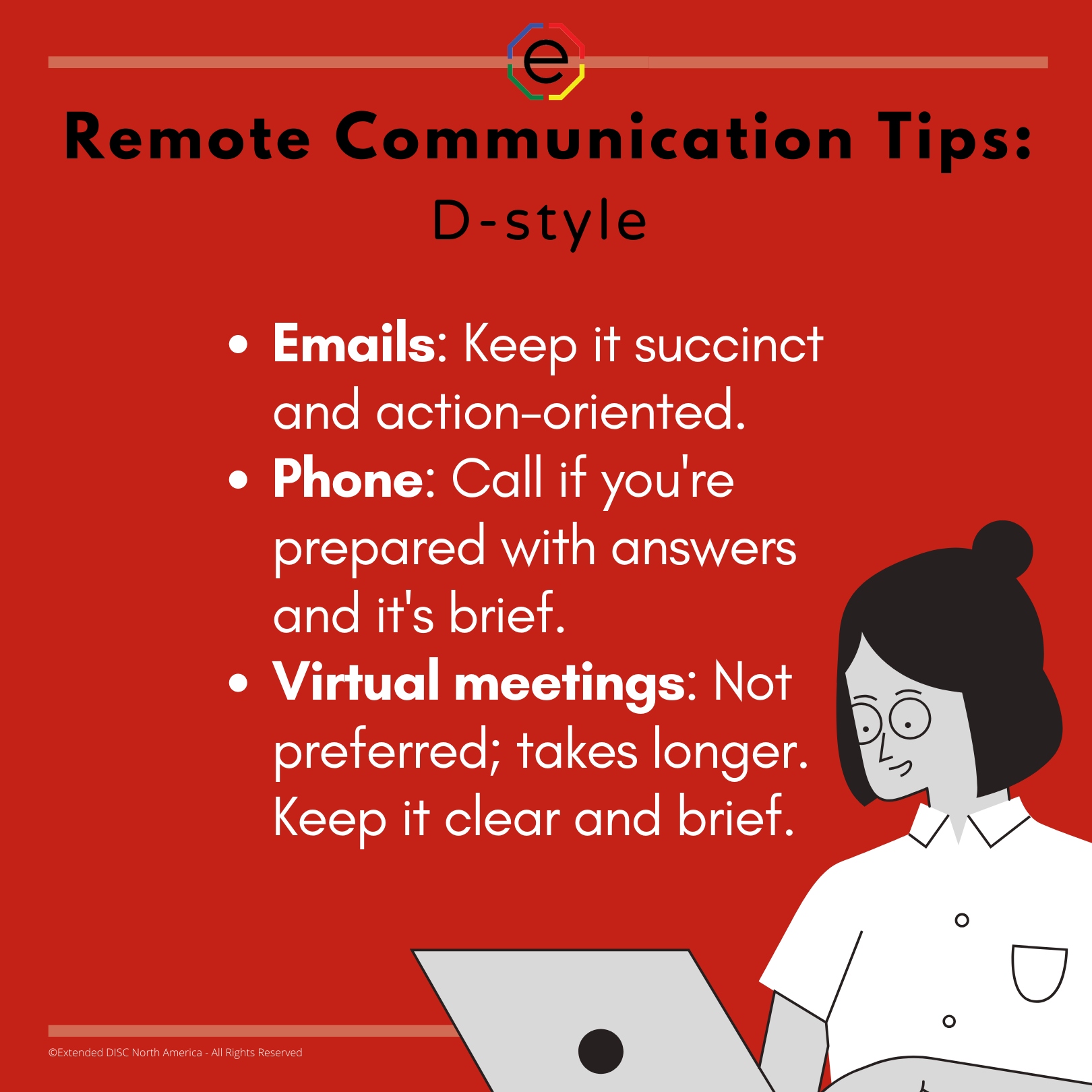
D-styles want you to get to the point quickly so keep your written communication succinct and action-focused. What are you asking them to do with your information? What’s the end goal and results for them? On the phone and in virtual meetings you need to be ready to go and keep it brief. D-styles act and decide fast because time is valuable. Be prepared with answers. They may become inpatient if it’s taking longer or focuses too much on chit-chat.
I-styles and remote communication tips

I-styles look many and a variety of interactions. Emails may be welcome though they may prefer you just pick up the phone. If you are sending an email, don’t overuse data and details because they may find it draining to go through it all. It may even get lost in their inbox. I-styles are more likely to respond if you focus on the positives, talks about them, and how it involves people .
Consider picking up the phone or setting up a quick virtual meeting. Live interactions are more likely to motivate your I-styles, especially when they have opportunities to speak and chat. While it may not be your preferred way to communicate, taking that time to engage with them is really going to make them more productive and in the end, accomplish what you needed. So, while it a phone call or virtual meeting seems to take more time, in the end it may likely save you time because the I-style is likely to respond positively.
S-styles and remote communication tips
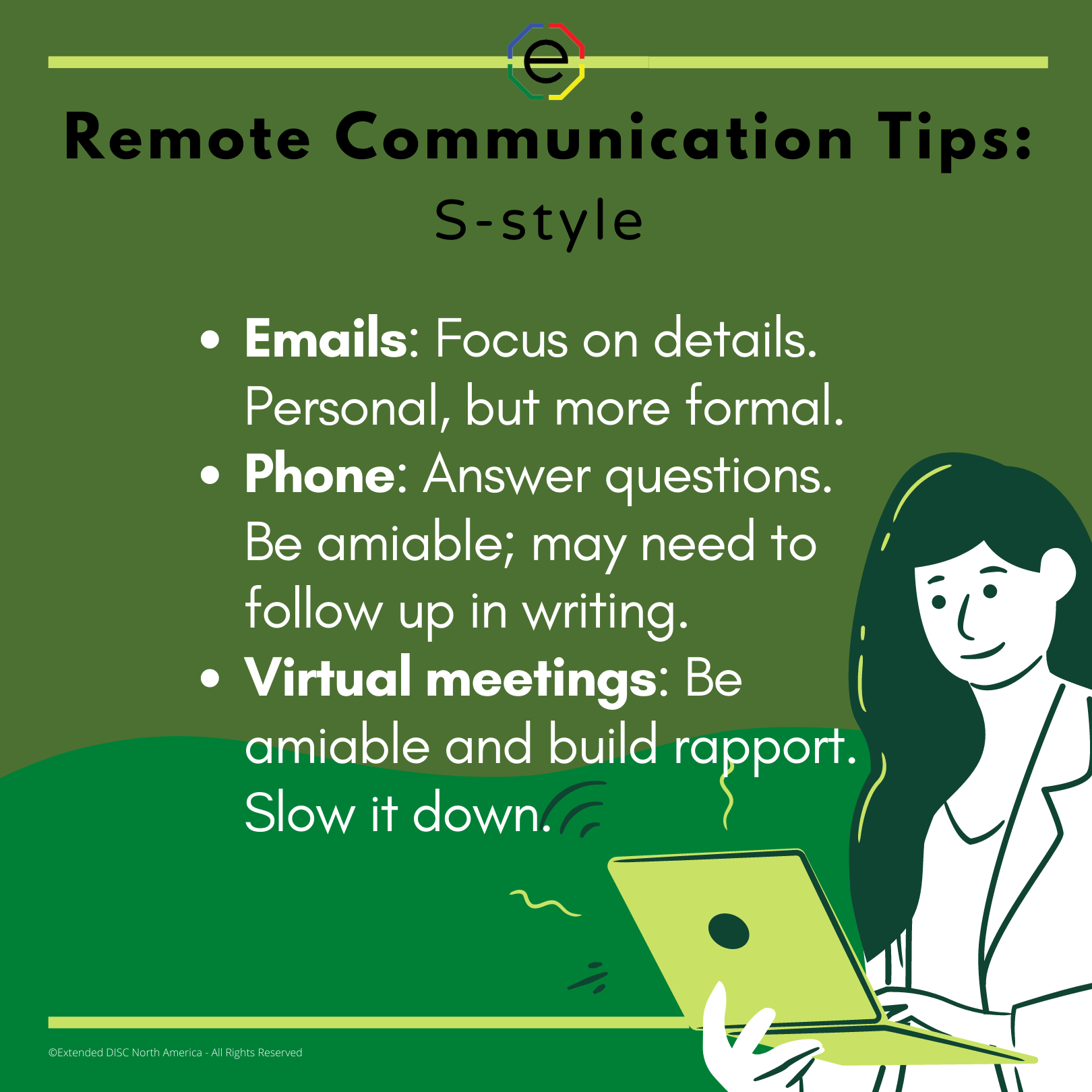
S-styles are a reserved style so they tend to be more formal and want more details and clear instructions. However, they are a people-oriented style so they will be more personable. Even if you give them a call, they may want you to follow up in writing on how to execute the plan or mutual agreement.
They tend to respond better in smaller group or one-on-one meetings. Remember to slow it down and ask them questions directly. When you do ask questions, make sure you give them time to respond.
C-styles and remote communication tips
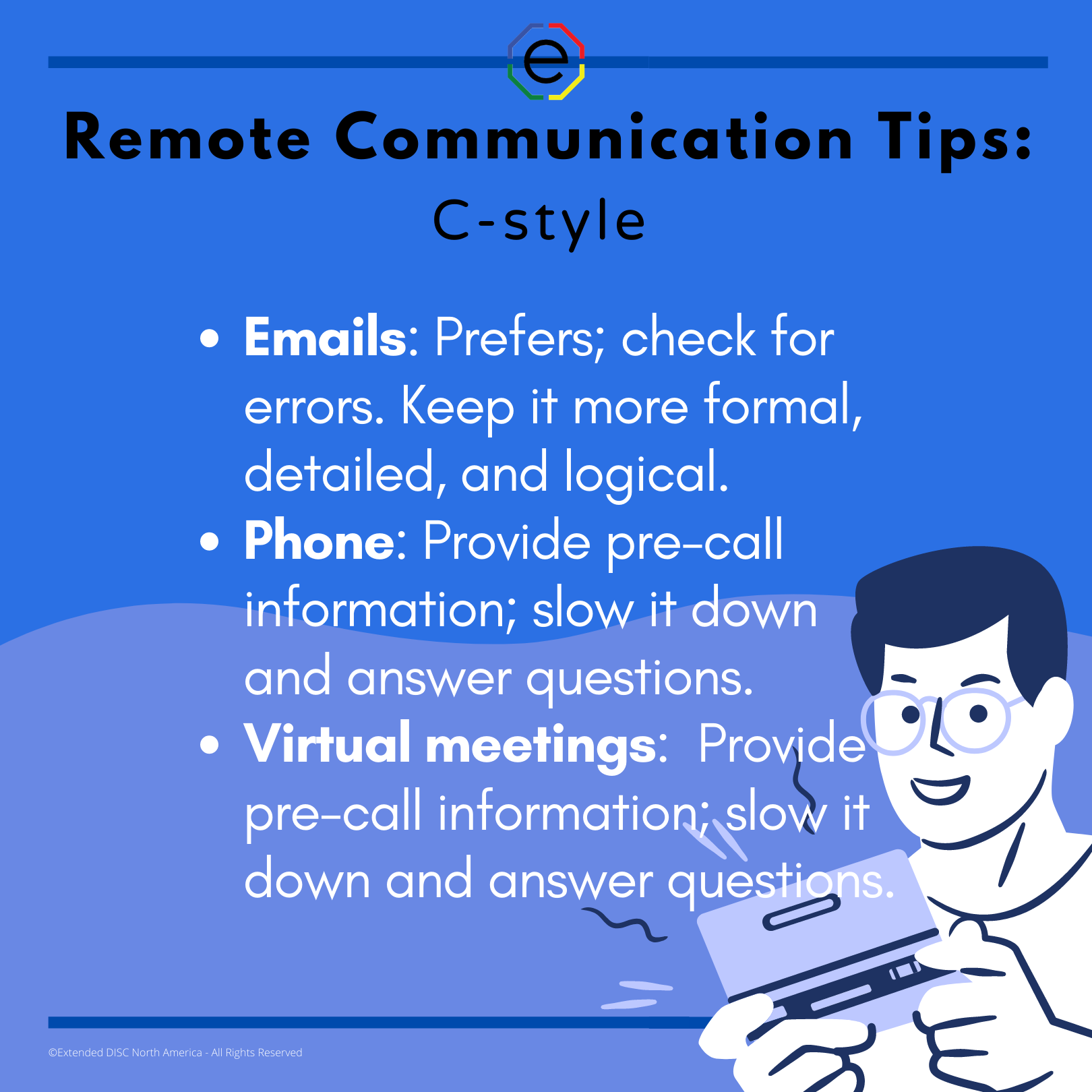
C-styles prefers written communication over live interactions. They want time to process the information and keeps the interaction more formal. They want to focus on the tasks. When sending emails make sure to answer their questions carefully and check your spelling and grammar. It may not be something we consider, but C-styles may respond negatively to emails that are not well thought out and correctly written.
Phones and virtual meetings are not a preference for the C-style. However, they will feel more comfortable if you prepare them ahead of time about what to expect. Remember, to slow it down and provide opportunities for them to process the information and take notes. They tend to be quieter, and may not ask questions right away. Don’t forget to follow up to see if they have more questions or need more information.
Final tips and takeaways
Take a moment to consider the style of others. We can help ourselves by practicing identifying the style of others. Remember, don’t jump to conclusions too quickly. Continue to refine your identification of their style as you gather more information about them.
DISC helps you make supported decisions on how to create better outcomes from your interactions. We use DISC to remind us that our communication preferences may be different and with some brief and temporary adjustments on our part, we can decrease the frustration and increase the productivity and outcomes.
Lastly, take a moment to breathe. It’s the action to that pause we all need between each interaction so we can refocus and reset to create the best outcome possible.
Staying Motivated with New Year’s Resolutions
Clean slate; time to make your New Year’s resolutions! How can DISC help you make goals you are motivated to see all the way through?
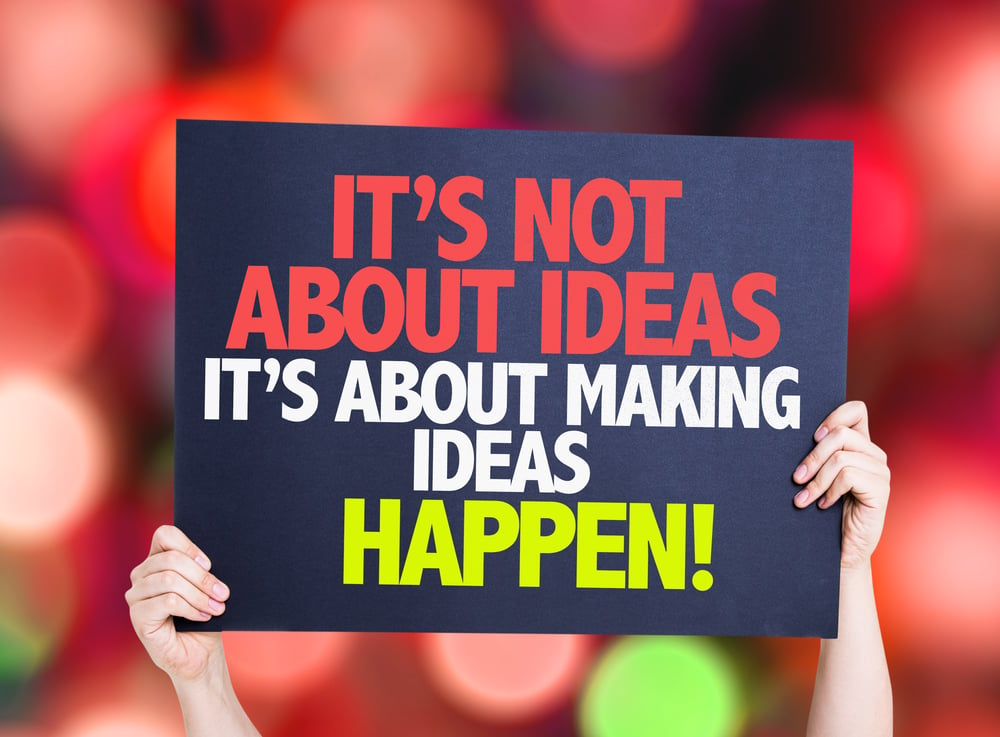
New Year resolutions can be a motivating jumpstart to reaching our goals; not to mention, it helps us feel better about what we didn’t do the past year. However, goals need to be more than a subject word; they need to be action-oriented to get it done.
One way to make goals more attainable is to start by creating ones that motivate you. All too many of us have created goals that are idealistic or far beyond our reach. Does the word “diet” ring a bell? It’s great to stretch for our goals, but getting started and maintaining momentum often sucks all of our energy, and we end up falling short.
DISC and goal setting
Your DISC style impacts everything you do, including goal setting. So, why not use it to your advantage? We can’t escape our style; so why not use it to guide us in setting goals and to finding the best path to achieving them? DISC helps you better understand how you prefer to do things; including, what motivates you, what you tend to avoid, and how you prefer to achieve goals. Isn’t that what you ultimately want?
Remember, there is no style better or worse; they are simply different. Let’s looks at what goals tend to be motivating for your style.
Setting motivating goals for your style
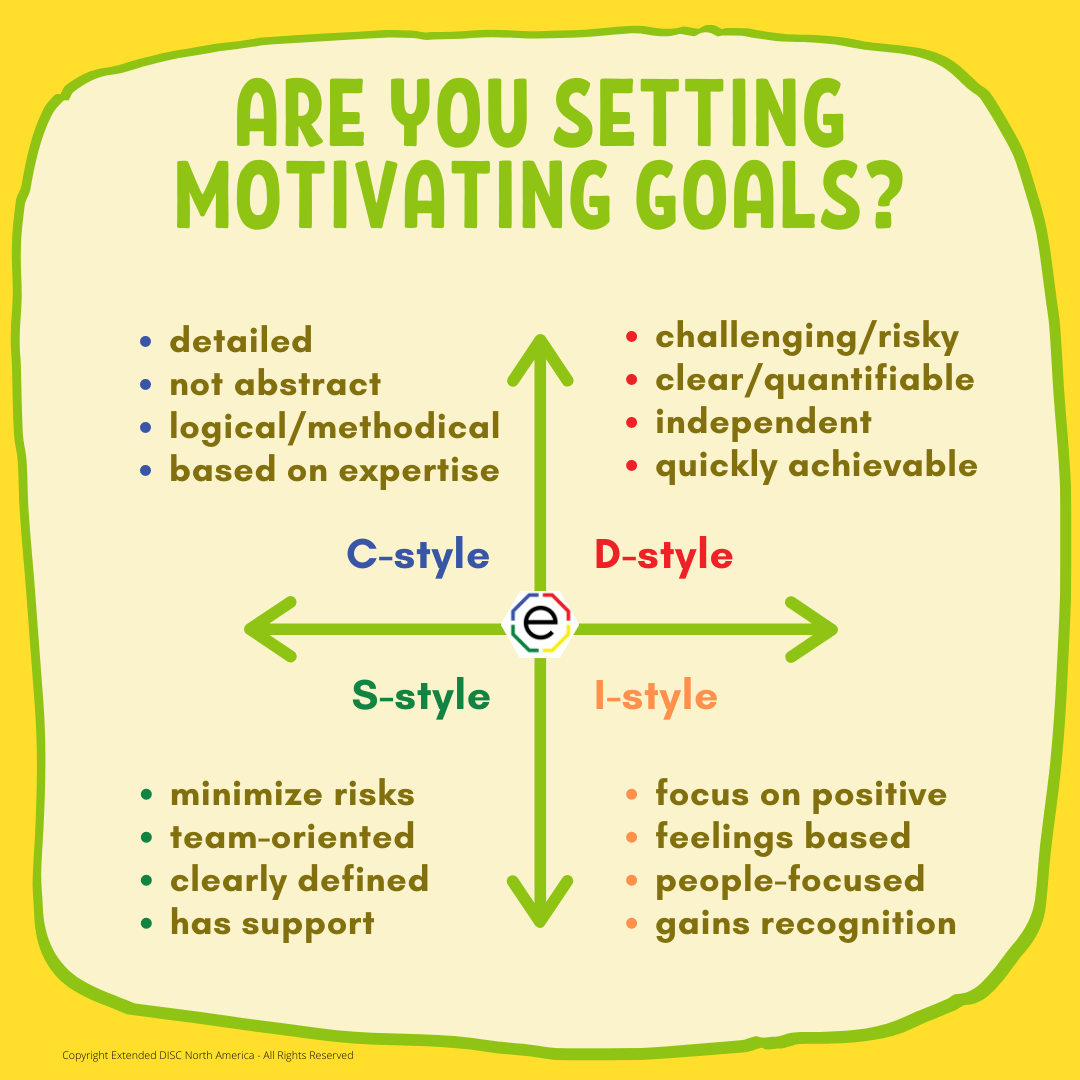
D-styles are driven and independent. You are more comfortable taking risks and setting challenging, multi-focused goals. You may lose motivation when you don’t see immediate results or you don’t have some control of the outcome. As a D-style, you want clear, quantifiable goals; preferably, achievable in the short term. Get started right away, and build in flexibility to get to an end goal you can see.
I-styles tend to be more impulsive and want more flexibility. As an I-style, use your enthusiasm to get yourself off to a great start, but keep pushing to see it to the end. Don’t focus on the glory of finishing before you start. Practice following through before you move on to the next exciting goal! Make sure to focus on the tasks and details needed to achieve them. Try focusing on short-term goals that deliver frequent gratification you get to share with others. Let’s make it fun and get it done!
S-styles prefer step-by-step directions and a clearly laid out plan. As a careful planner, you may be slower to start; spending more time on the planning of getting ready. Don’t lose sight of the goal! Use your support network to motivate you. Sometimes, taking that leap and getting going is often not as difficult as you thought it would be! And, it makes it that much closer to your goal, and we know your persistence will get you there!
C-styles want clear, logical goals that rely on their expertise. As a C-style, you can overly focus on small details instead of stepping back and understanding the broader scope of what needs to be achieved. Don’t worry about criticism and small failures; focus on moving toward the end goal. Try getting off to a quicker start; there is some truth about too much data. Practice focusing on the positives of what’s going well and soon you will find yourself closer to the end point!
Committing to your goals
DISC helps remind you how your goals and paths to achieve them are different from others. It can also help your team come together by identifying its strengths and team dynamics. Everyone on your team has shared goals, but how you reach them depends on what you do independently and how well you come together as a team.
DISC also helps you understand what may be barriers to achieving your goals. Goals and pressure to achieve them go hand in hand. We tend to revert to our natural style under pressure because we don’t have the same focus and energy to make adjustments. For example, a D-style under pressure may begin to tunnel vision on what can be achieved quickly. They may not take into account the opinions of others or they begin to make mistakes by taking too many risks and moving too quickly. You can make better adjustments by knowing how you show up.
Give yourself a jump start!
Are you a big picture person or do you need step-by-step planning? Do you need to build in quick rewards or have back-up plans? What is the simplest course of planning for your style? Your stronger self-awareness helps you understand and practice the adjustments you need to make toward achieving your goals.
First, you need commitment to the goals you’ve made. DISC helps you commit to goals that are more motivating to your style, which means you have already taken a step forward. You can be more flexible by rewarding yourself along the way. Now, when the work begins, you can use your style to create a clearer path to achieving your goals. Let’s go!
Communication Preferences: Are You Getting Your Message Across?
Have you ever felt others are speaking a different language than you, even though it’s really the same language?

Communication is the exchange of information and ideas with others, but it’s not always received as it was intended. We’ve all had times where we’ve rolled our eyes (maybe internally), let out a long sigh of frustration, or been completely dumbfounded at the message. What is this person trying to tell me?! What about those confusing email responses showing how they completely misunderstood you? You try again and again, and the emails are flying back and forth with no end in sight.
Have you ever had to inhale deeply before speaking with your colleague or client because you know it will be a frustrating interaction? They have trouble understanding you and you have trouble understanding them; the interaction just doesn’t work.
Thankfully, there’s also the other end of the spectrum where the conversation just flows. You just understand each other; sometimes without even speaking. Unfortunately, many interactions don’t happen that way. So, how can DISC help?
Understanding our communication preferences
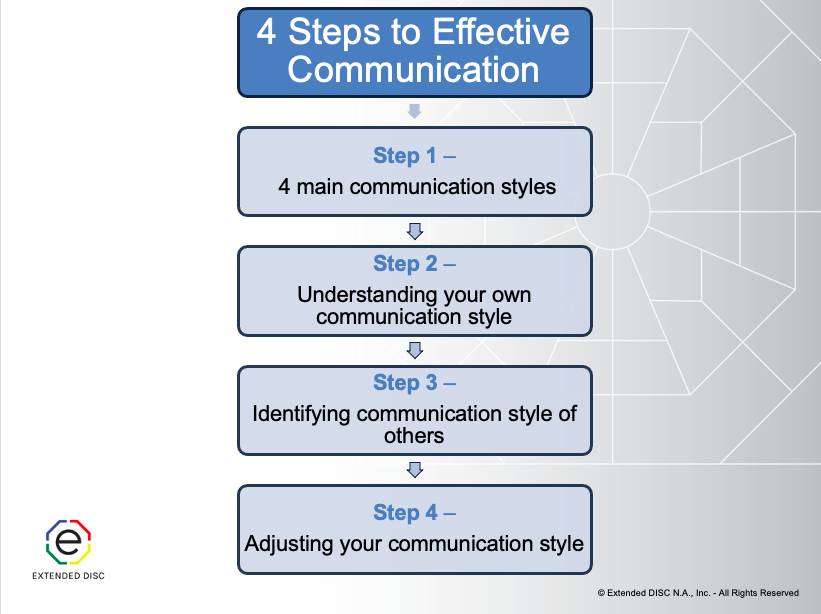
We tend to communicate in ways which are more comfortable for us. This may be similar or different from others. DISC states there is no better or worse style; only different. We all have strengths and challenges. In fact, the most successful people are the ones who use their strengths wisely and do not ignore their challenges. Their success is because of their keen self-awareness and knowing when to make adjustments.
DISC helps us build self-awareness of our own style and how we show up to others. Are you open and chatty? Would you be surprised if others described you as someone who talks too much and is overly emotional?
DISC also helps you to identify the preferred communication style of others. Now, you have valuable information to make better decisions on how to adjust your style effectively.
Let’s look at how each main style prefers to communicate and how to get your message across.
What are More Effective Ways to Get Your Message Across to D-styles?
D-styles are most comfortable when they are in control; dominating the interaction. They speak and you are expected to listen. When the roles are reversed, they tend to be impatient listeners. As an independent, task-focused style, they can ignore input from others. They are more direct; which can come across as blunt and insensitive to others who don’t speak their language. D-styles express their opinions as facts; expecting no further discussion.
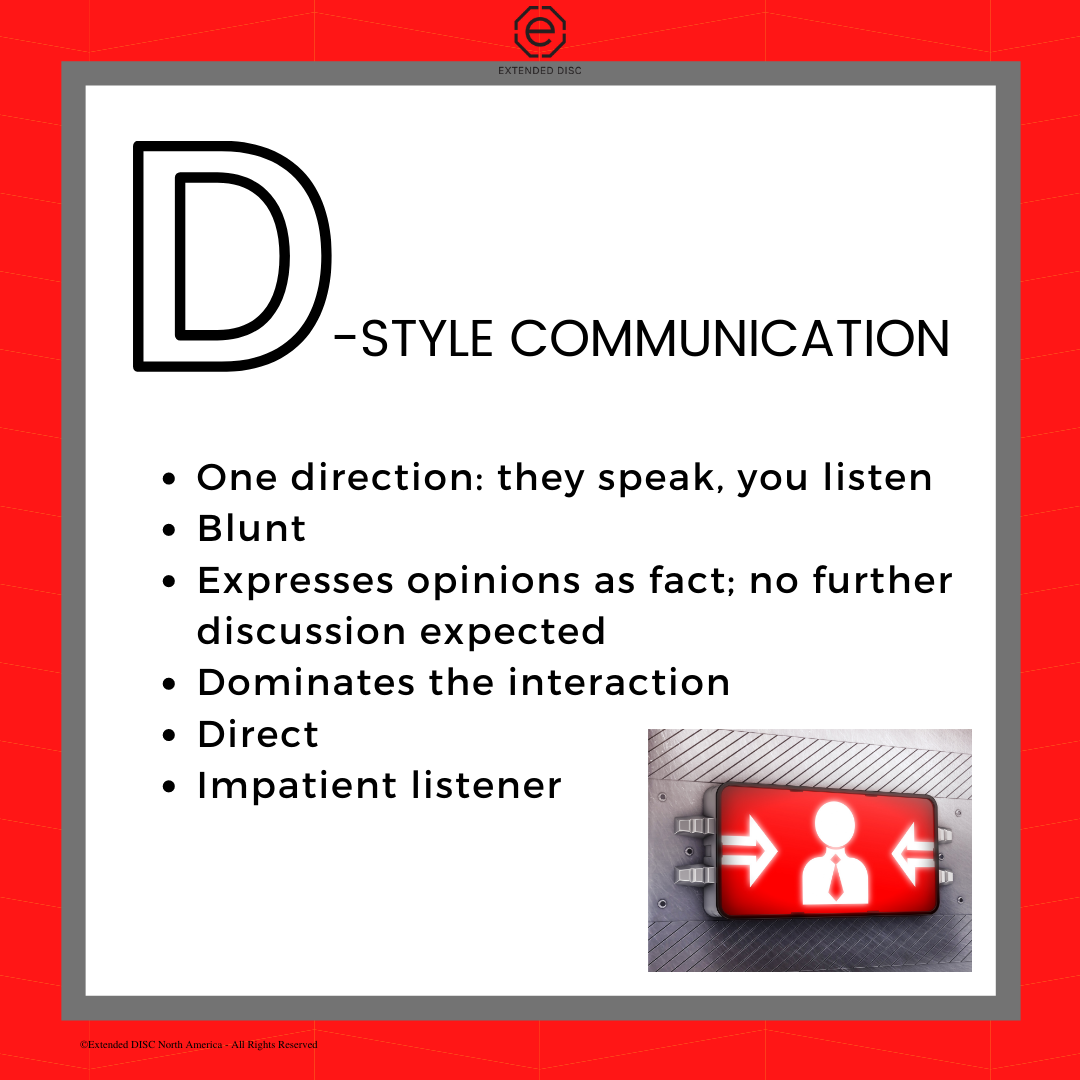
Here are some tips for speaking the D-style’s language:
- Act quickly because they decide fast.
- Give them options so they feel they have the power to decide.
- Provide immediate feedback.
- Focus on results and quick action.
- Touch on highpoints; don’t overuse data.
- Do not focus on emotions or be too chatty.
In this day and age, we are communicating more and more across a variety of platforms. DISC can help you better identify virtual styles of others.
When emailing D-styles, keep it succinct and action-oriented; just tell them what they need to know and identify a call to action. Remember, their responses will be more direct and exhibit a demanding tone; telling you instead of asking you. Use the phone if it is more efficient, but keep it brief and be prepared. Virtual meetings may not be preferred by D-styles because it can take more time. Remember, to keep it brief, clearly identify goals, and provide actionable next steps.
Who is Listening? Communicating Your Message to I-styles
We may assume communication is easier for I-styles, since they’re naturally more social and talkative. However, it is not a given. DISC describes the I-styles behavioral preference for opportunities to interact with a variety of people. I-styles are charismatic and more focused on emotions over details and tasks. What DISC does not identify is their ability to communicate with people, only that they prefer to.
I-styles prefer avoiding unpleasant topics; preferring to focus on the positive. We often go to the I-style for positive feedback. However, they tend not to listen to details or for very long.
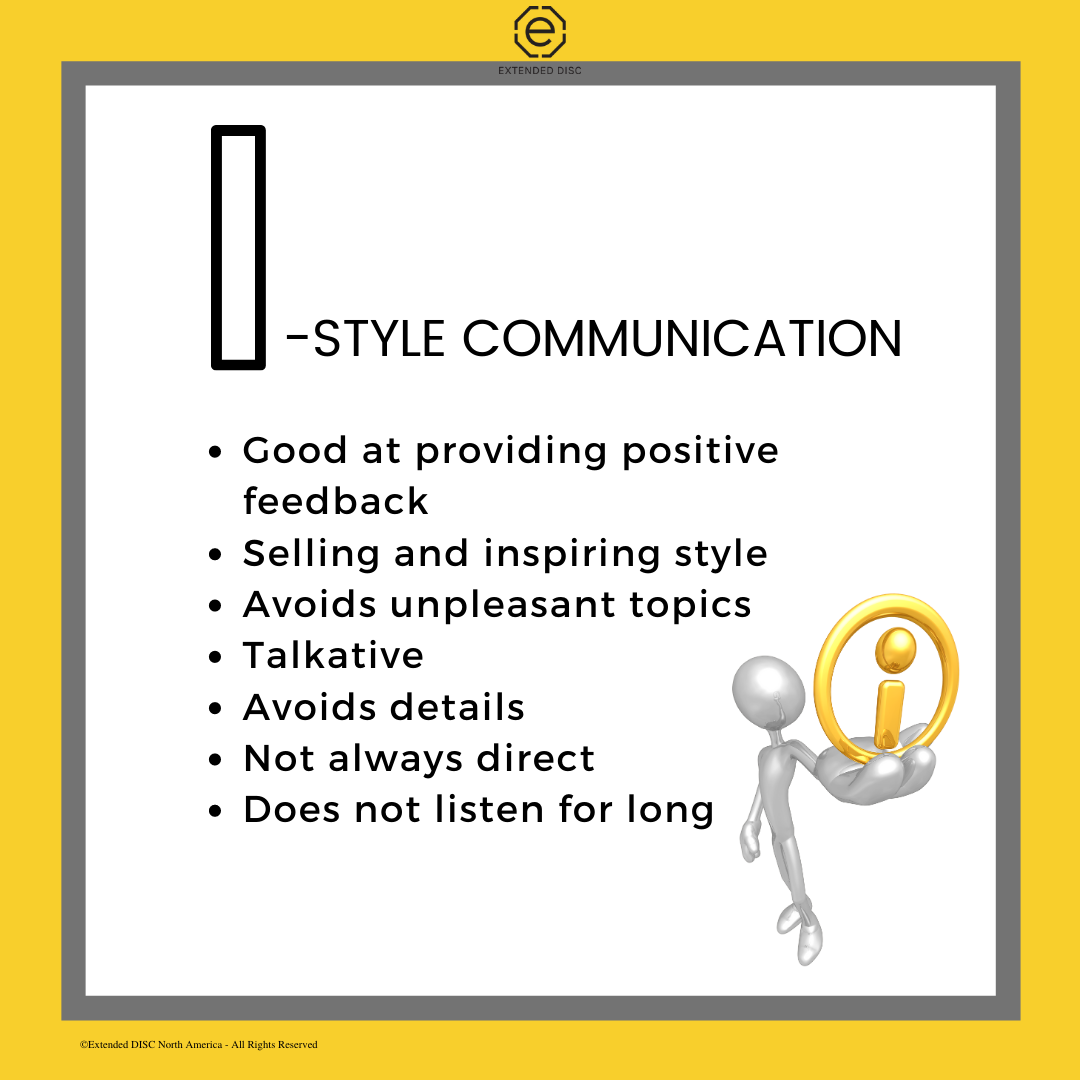
Here are some tips for communicating with an I-style:
- Build in time to chat.
- Focus on the positive; try not to react negatively.
- Show enthusiasm.
- Let them speak.
- Focus more on them, rather than the tasks and details .
Don’t overuse data or include too many details when emailing I-styles. Try to focus more on positivity and keep it friendly. Better yet, consider picking up the phone and calling them, but build in time to chat. I-styles respond well to live interactions such as phone calls and virtual meetings.
How S-styles Prefer to Communicate
S-styles prefer communication in one-on-one settings where trust is built. They are amiable and patient listeners, but will usually answer your questions only when asked. They want time to understand your perspective. S-styles tend to speak calmly and talk about topics that they’re familiar with; usually in detail.
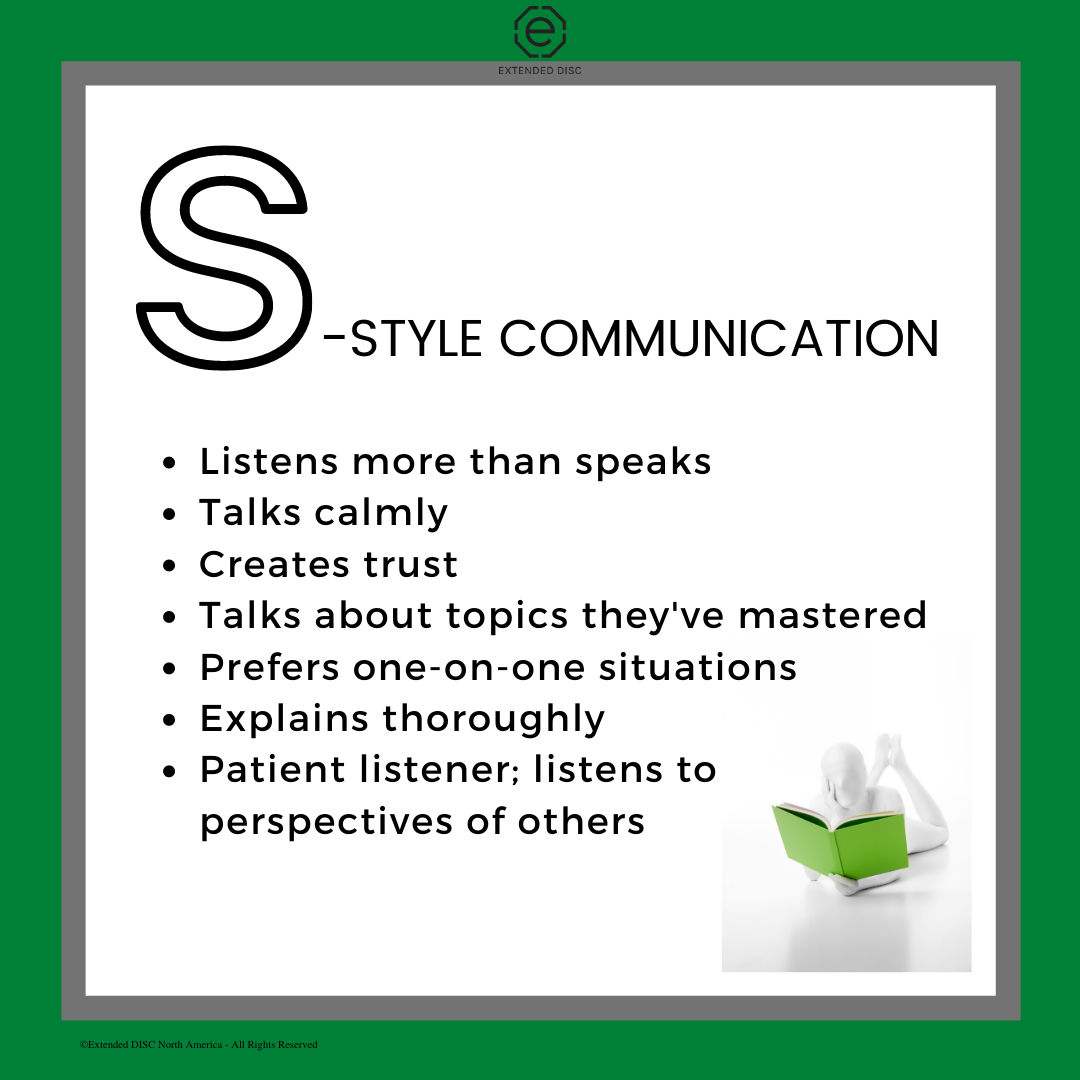
Some tips for interacting successfully with the S-profile:
- Slow down and explain carefully.
- Allow time to think and talk about it with others.
- Build rapport and trust.
- Provide assurance and support.
- Don’t make sudden changes.
- Keep your promises.
S-style emails tend to be friendly and well thought out. They may sign off with, “Best regards” or “Sincerely,” instead of “thanks!” S-styles are the team players of the styles so they are more likely to use the pronouns, “we” or “us” over “I” and “me.” They are more likely to ask you to do something rather than tell you. S-styles seek information so they can make the best decision for their teams.
Try providing reassurance by answering their questions carefully, and progressing step-by-step. When emailing the S-style try using plural form when addressing them, “we” or “you and your team”. Also, be sincere and if possible, build rapport. Don’t push them into quick decisions and be sure to follow up and do what you agreed upon.
Why Your Message to C-styles May Not Be as Effective
C-styles prefer written communication; specifically, with a lot of details and fact-based information. They are more quiet, reserved, and diplomatic. C-styles may come across as timid because they tend not to speak or express disagreeing views. They are most comfortable discussing topics they have expertise with and avoid more abstract topics. They can be critical listeners, but so focused on details and correctness, they don’t stand back and see the big picture.
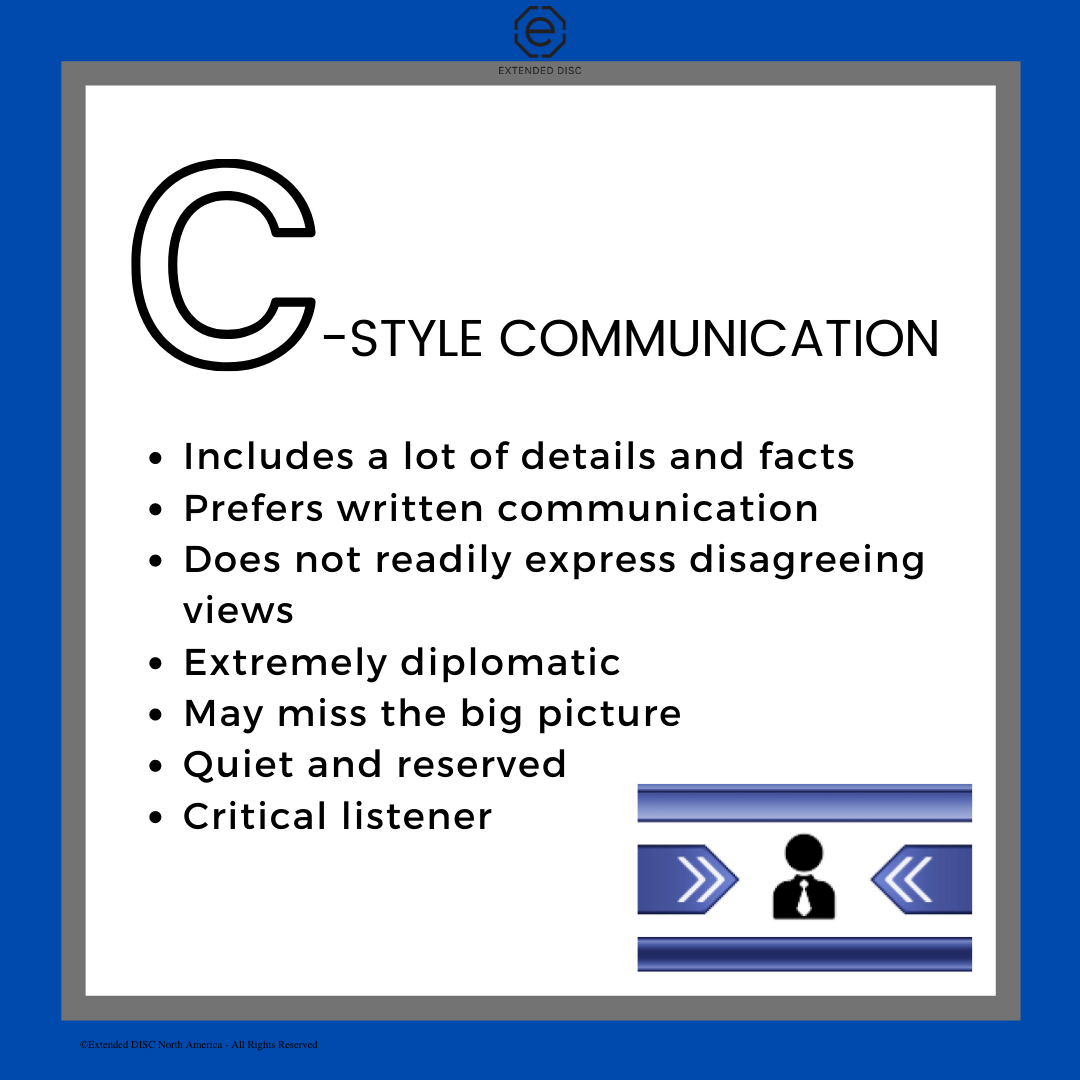
Tips for improving interactions with C-profiles:
- Provide time to think and answer all of their questions.
- Explain carefully and give sound reasons and data whenever possible.
- Be patient with the details.
- Provide information; preferably in writing and ahead of time.
- Don’t be too chatty.
C-styles prefer emails over face-to-face since they are naturally more reserved and more task-oriented. Their emails tend to be more detailed and formal. It is probably fact-checked and reviewed for punctuation so proofread your emails and answer their questions carefully or they will not be able to move forward. If you’re calling or meeting virtually, try scheduling the call and letting them know what you’ll be discussing ahead of time. Expect the C-style to be quieter, but provide them with opportunities to ask questions. Don’t rush or move too quickly. Be sure to follow up and be prepared with supportive data.
Speaking the language of the styles
DISC reinforces our communication style; how it may be different from other styles. It also helps us better identify the style of others so we can communicate in a more common language. Ask yourself if you need to speed it up or slow it down, use bullet points, or pick up the phone in your next interactions. Simple adjustments can alleviate the frustrations and enhance the opportunity to get your message across. Both sides end up benefiting through the exchange of productive information.
Owning Your Strengths and Taking on Your Challenges!
Are you a successful person who owns your behavioral strengths and doesn’t ignore your development areas?
You are most engaged when you’re able to tap into your strengths. Behavioral strengths feel more comfortable and motivating, while development areas feel more challenging and energy draining. A better understanding of your strengths and development areas lead to confident self-awareness. However, self-awareness is still only one piece of the puzzle. Your goal is to learn how and when to modify your behaviors to improve communication, interactions, relationships—and ultimately; success.
Overview
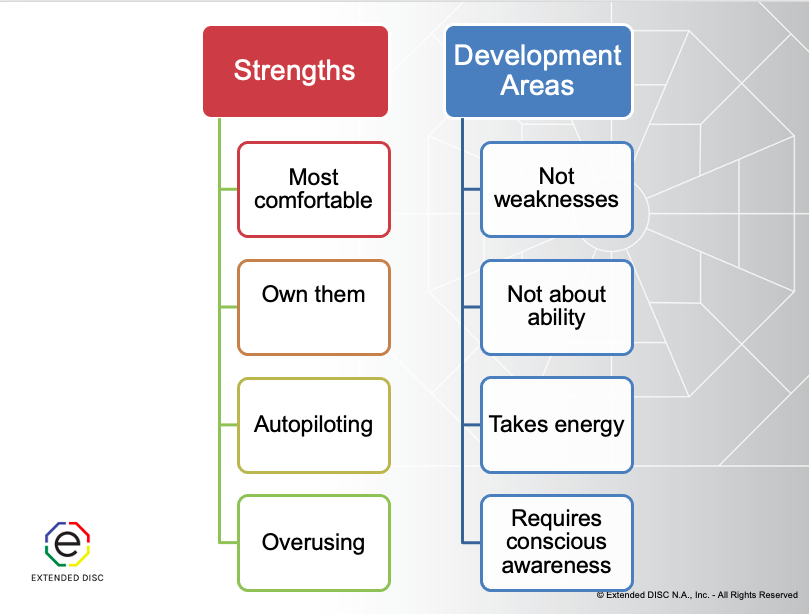
The Extended DISC® Assessment describes your strengths as behaviors that feel most comfortable to you; basically, you own them. Alas, you don’t automatically rock them because it’s not about ability. Strengths can end up as a liability when you overuse them. You tend to rely on your strengths because they don’t take conscious thought or energy. Sometimes, you rely on them too much and end up overusing them. For example, if you’re a talker, have you ever gotten into trouble for talking too much?
Development areas are not automatically your weaknesses. They are behaviors that don’t feel natural and take more energy. We may even try to avoid them. However, our roles and responsibilities often require us to push outside our behavioral comfort zone. Can you do it? Of course; especially if you have a starting point! Try thinking of your behavioral development areas as challenges you can certainly develop if you tried.
Knowing your strengths will help you tap into them and knowing your development areas provides opportunities to manage them. It really comes down to energy; strengths don’t require energy and development areas do.
Next, let’s look at the strengths and challenges for each of the main DISC styles.
D-style strengths and challenges
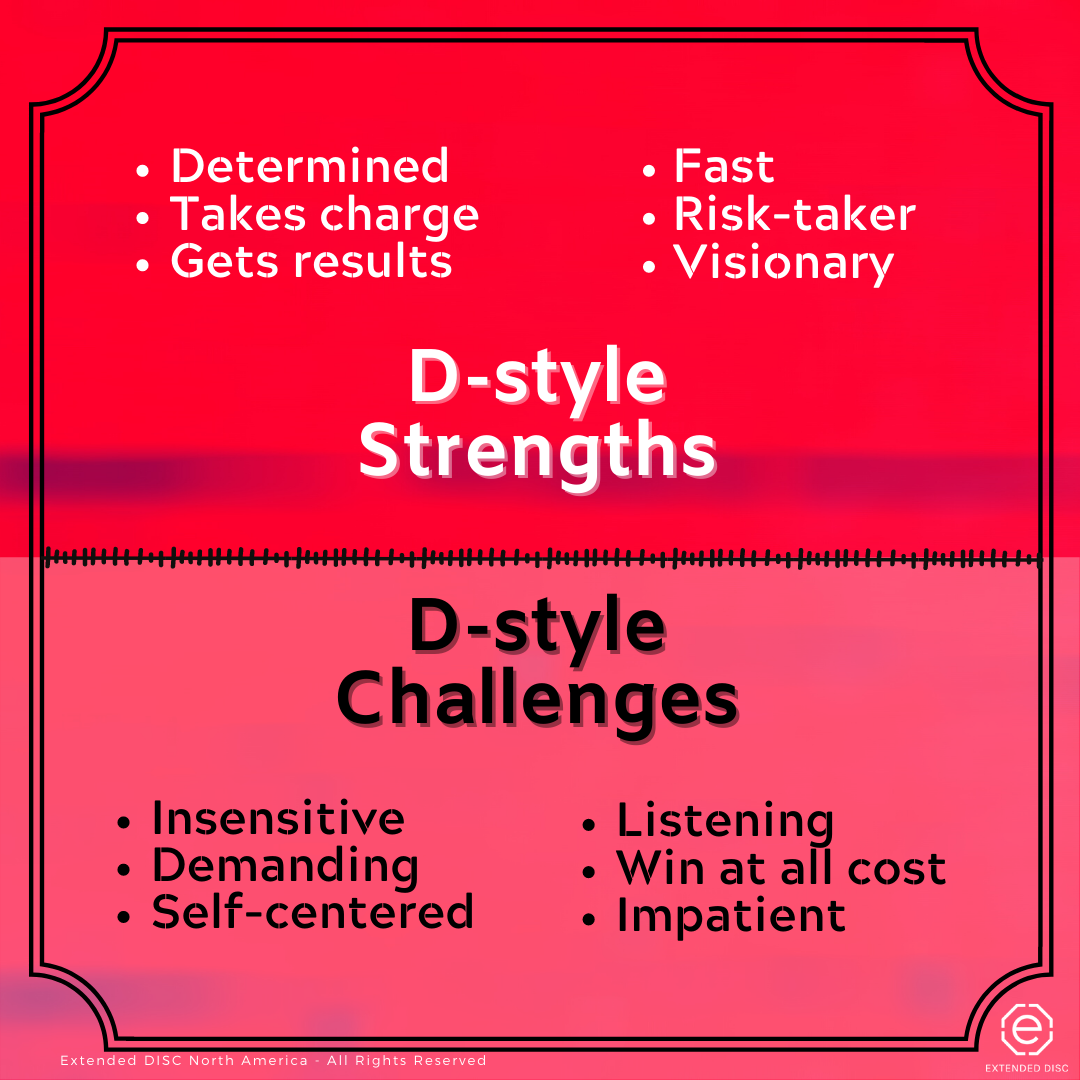
D-styles are your independent task-focused styles. They rely on their determination and preference for taking charge to make things happen and achieve results. They think outside the box and thrive in fast-paced environments. D-styles are willing to take risks to achieve great rewards, which, oftentimes benefit the rest of us.
We tend to see the challenges in our D-style colleague as being insensitive and self-centered. They can tunnel vision on their own tasks and accomplishments. Their laser focus can cause them to ignore input from others. The fast-paced D-styles can come across as demanding and impatient multi-taskers. Their need to control interactions creates a unidirectional way of communication; they speak and you listen.
D-styles can make better adjustments with conscious awareness and practice. They can slow down, listen more, and be more patient. D-styles can sometimes get faster results if they set aside some time for small talk or listening more.
I-style strengths and challenges
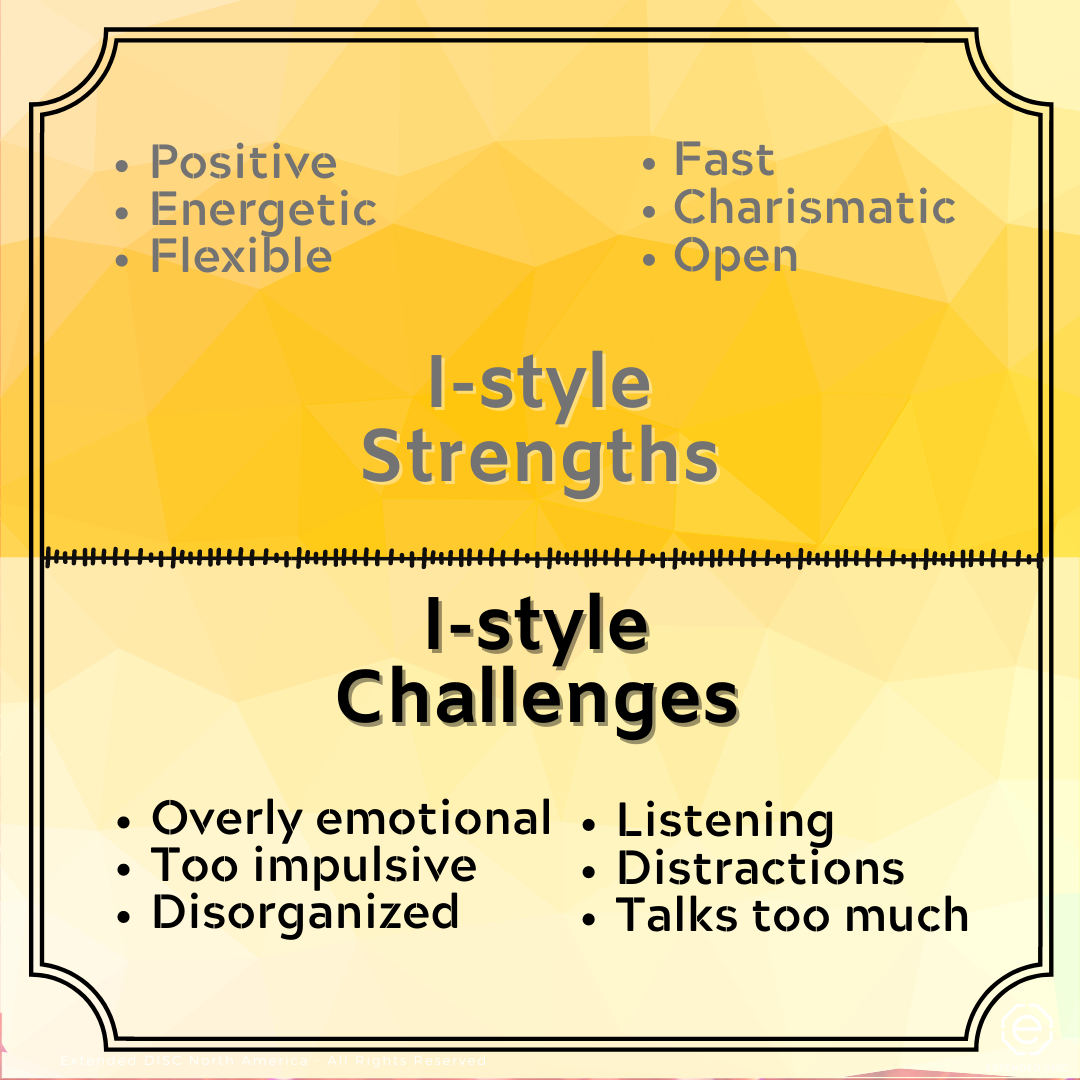
We love the I-style’s enthusiasm and optimism. Their energy and emotion show on the surface. They are charismatic and sell their ideas well. I-styles are flexible and use their sociability to set the positive tone for our team and connect people.
Challenges for the I-style are being overly emotional and easily distracted. They are social butterflies, but they can end up talking when they should be listening. I-styles prefer variety and focusing on the big picture so details and tasks can create disorganization.
I-styles should rely on their ability to communicate verbally, but know that sometimes it’s more productive to focus on the topic and listen. They can slow it down and focus more on facts before making decisions.
S-style strengths and challenges
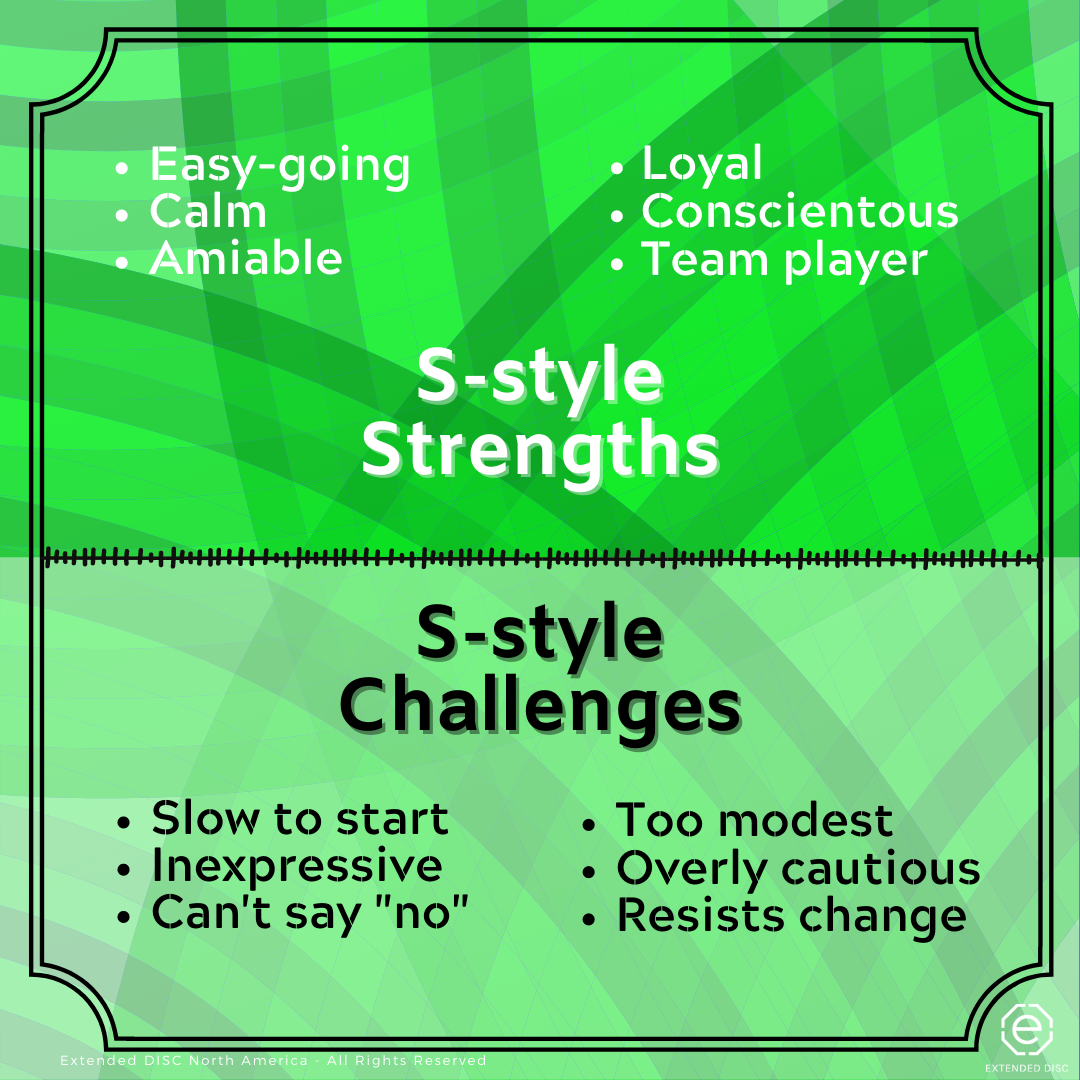
We count on our S-styles to be calm and steady. They are the team players of the DISC styles. We count on their loyalty and dependability. S-styles strive to build strong relationships and are very conscientious. They use their strengths to support their team and create a stable and dependable team environment.
As the team player of styles, the challenges for the S-style, is their inability to say “no.” S-styles may be too modest and therefore, do not speak up. Their desire for stability can make them more resistant to change and overly cautious. We describe S-styles as indecisive and slow to start; they desire other’s viewpoints and want to make decisions that have a positive impact on the people around them.
S-styles can practice speaking up and verbalizing their thoughts and emotions. They may even realize that it wasn’t so bad to just jump in and do it.
C-style strengths and challenges
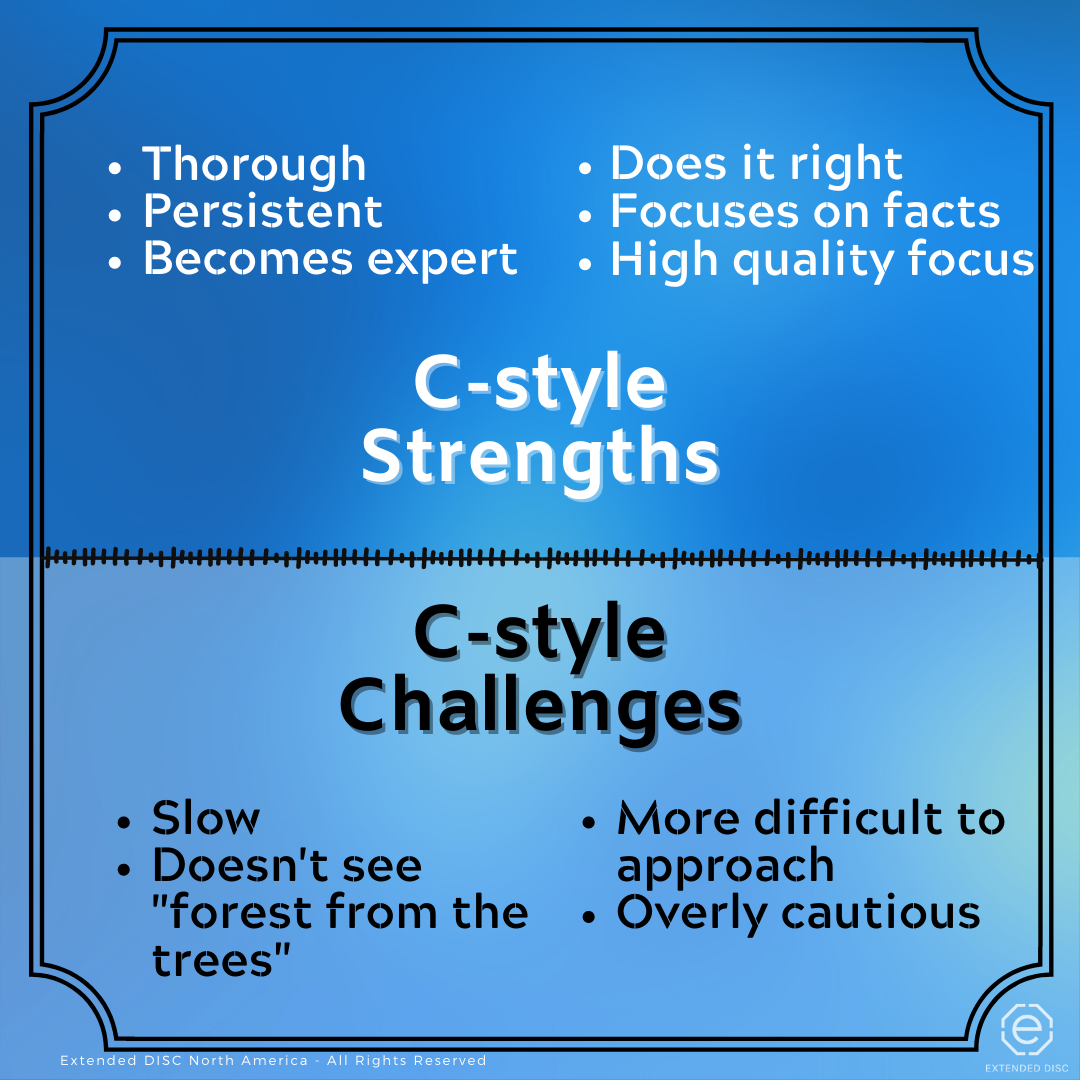
Who do we run to when we have a problem to solve? Typically, it is our team’s expert, the C-style. They are more focused on doing things correctly and taking time to understand the processes and products. They are our voice of reason and facts.
A challenge for C-styles is their desire for perfection. Their focus on details can sometimes prevent them from “seeing the forest from the trees.” They tend to move slowly and cautiously because the process needs to be logical and correct. They are more reserved so others may find them difficult to approach.
C-styles can challenge themselves to speaking up and focusing more on people, rather than details and facts. They can work on being more expressive so they don’t appear distant. They can practice letting go of mistakes because sometimes mistakes are just part of the learning process.
Using your strengths and taking on your challenges

Some of us stick to our path to success and don’t consider the need to change, “hey, it’s been working for me all this time!” At some point, our style will not be the best fit and knowing when and how to adjust is the magic key.
However, don’t overlook your strengths; recognize them and use them because your job is tough enough! Don’t take your strengths for granted and assume ‘everyone can do that.” If you are thorough and methodical, don’t assume others are the same. Autopiloting on our strengths can happen when we get too comfortable; alway remember to make appropriate adjustments in your daily interactions.
Be aware that strong emotions, such as stress and frustration, can divert your energies away from behavior modification. Your focus on managing those strong emotions can cause you to rely only on your strengths; sometimes, overusing them.
Next steps

Consider your own strengths and whether you’re taking advantage of these valuable behavioral traits. However, don’t overuse them to which they become a liability to your performance. Ask yourself these questions to maximize your strengths and address your challenges:
- What strengths are you currently capitalizing on?
- How have they specifically contributed to your success?
- Can you use them more effectively? If so, how?
- Can you identify situations when you’ve overused a strength?
- What can you do differently going forward?
- Are their any additional strengths you should be capitalizing on in your current position?
- State a current goal and identify how you can use your strengths to achieve the goal.
- Which of your behavioral challenges, if addressed, creates a significant impact on your performance?
- What are the specific actionable steps you will implement to take on these challenges?
By increasing your understanding of your behavioral strengths and challenges, you are that much closer to making better decisions on how to be more successful.
Tips to Debriefing DISC Profiles
Read this if you could use tips on debriefing DISC Profiles.
Many of you debrief DISC Assessment results regularly with your clients and employees. You may be doing it in a workshop or one-on-one. Regardless of how you debrief, we have some tips and brief refreshers to help you and your clients better understand their Profiles results.
Why DISC results are not all the same
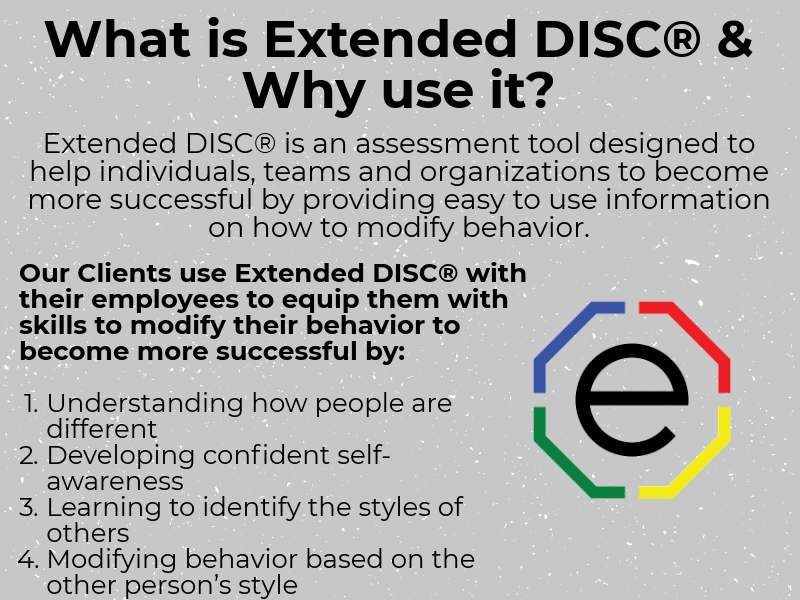
It’s not uncommon for your participants to tell you they’ve already taken a DISC Assessment. Your best response should be, “That’s great! Was it the Extended DISC Assessment?” People don’t often realize the DISC model is universal, but not the tools.
In fact, there are different DISC tools available; sometimes measuring different things. DISC tools are based on the DISC Model and describe main DISC styles similarly, but they may vary on what is measured and how they present the results.
Extended DISC identifies your present perceived need to adjust style and your natural style, but focuses on your natural style. You can make better decisions because the results show who you really are. Your natural style predicts the behaviors which are most comfortable to you; how you prefer to do things and how you show up when you’re not adjusting.
Do you trust the results? One thing we should always ask when using assessments is, “can we trust the results?” We make important decisions off of the results so accuracy is critical. Revalidation and international validation (not just one country or one language) strengthens the confidence in your results.
Now, let’s look at debriefing Profile results.
Profile results
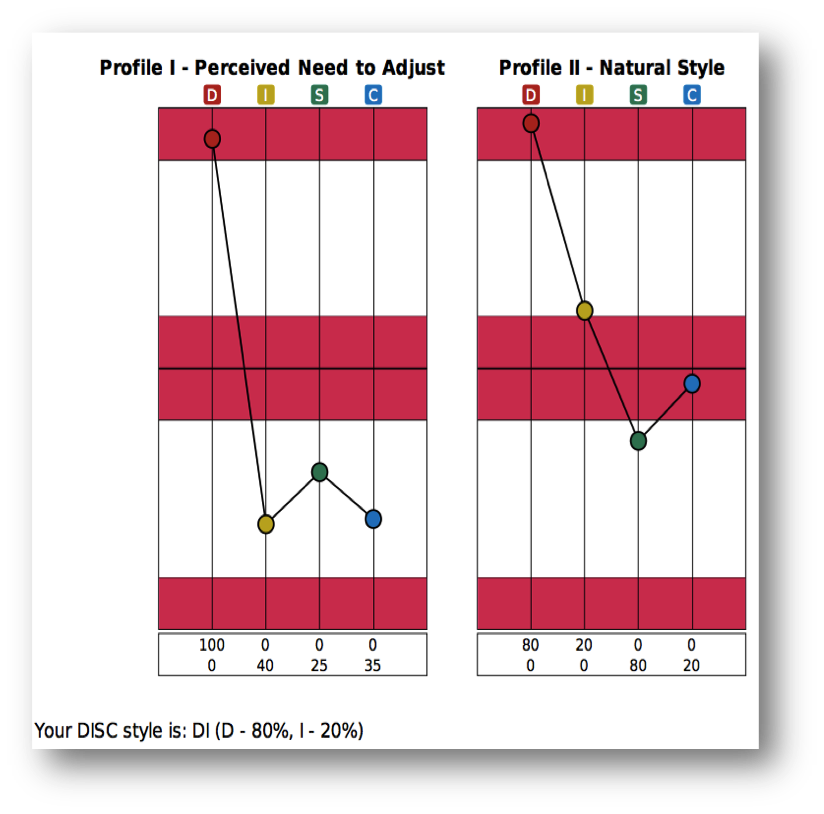
The Profiles graphs are a visual representation of your DISC style. They are based on your responses to the Extended DISC® Questionnaire. The Questionnaire generates two Profile graphs, Profile I and Profile II. Profile I represents your perceived need to adjust in your present environment and Profile II represents your natural style.
A great tip, as a coach, is to also view the Profiles first. One reason, is you want to determine if you can trust the results. Long, stretched Profiles provide confidence in results interpretation. The larger the gap between the dominant style (highest plot point) and the least comfortable style (lowest plot point), the more clearly and consistently you are identifying your natural style over your style that is not natural to you. In the Profile II – Natural example above, the person is a dominant D-style and their least comfortable style is S-style. You can see a clear gap between the D plot point and the S plot point.
Tips to debrief Profile I
Profile I describes how you feel you need to make adjustments in your present environment. A great analogy is to describe it as a snapshot of how you felt you needed to be at the time of the assessment. It is your transient profile; meaning that it constantly changes as your perceived reaction to your environment changes.
Another tip is to not put a lot of emphasis on Profile I. Remember, the title is “perceived” need to adjust. It is simply your belief of how you feel you need to adjust your natural style at the present time. However, the perceived adjustments are not automatically the best ones. For example, you may perceive you need to speed things up and take more risks, but that may not be what your manager believes.
The last tip to always interpret Profile I by comparing it to Profile II. Profile I is all about your adjustments. In order to understand the adjustments, you need have a starting point. Profile II – Natural Style describes your most comfortable way of doing things; hence, it’s your base point.
Tips to debrief Profile II
Unlike transient Profile I, Profile II tends to remain stable, but not rigid, throughout the course of your adult lifetime. Profile II is your natural style. The easiest way to describe it is it’s your most comfortable way to do things; how you prefer to communicate, how you prefer to make decisions, how you prefer to lead, etc. It focuses on who the person really is.
The graph describes the relationship of all four DISC styles, but it is not an absolute scale. If your D-style is plotted higher than your colleague’s it does not automatically mean you are “more” D than they are. Also, if your D-style is plotted at the very top it does not necessarily mean you are the ultimate D; it simply means that you very consistently and strongly self-identified with D-style when answering the Questionnaire.
As DISC facilitators, we should always reinforce the concept that we have all four DISC styles; it’s just some styles are comfortable and some are not. It’s not about your abilities and it does not predict your success. You can help your participants understand their results by describing DISC styles in terms of energy; some styles don’t take energy from you and some do.
A few final and important tips
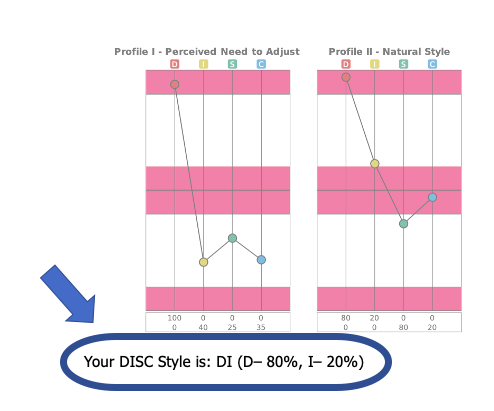
You know your audience best; there is no one way to debrief the results. However, you should always put the emphasis on Profile II – Natural Style. It helps people better understand their results because the report is primarily based off of Profile II. Understanding your natural style provides a clear starting point to make more effective adjustments and further development.
Your participants do not need to interpret their Profiles to understand the report results. Have them zero in on the statement directly under the Profiles. You can see in the example the statement reads, “Your DISC Style is: DI (D-80%, I – 20%.” Often times, we conduct workshops where we don’t need to or have have time to do a deep dive into interpreting the Profiles. Once they are able to identify their DISC style from the statement, they are ready for the rest of their report.
A final tip is to help them interpret their Profile results. We, as facilitators, can tell them their DISC Profile and what their Perceived Need to Adjust Profile is, but we cannot explain why they are a certain style and why they want to adjust in the way they do. What we can do is to ask more open ended questions such as, “what do you think of your results” or “how does that reflect where you are right now”? It gives them the chance to process the results and reflect on how they are needing to adjust.
Now, they are able to use the results of their report to create a behavioral action plan for improving their interactions. Ultimately, the goal of using the assessment is to help people be more successful.
Hope that helps and don’t forget to practice interpreting Profiles!
Holiday Joy and Stressors: We All Have Them!
Wait…how many days until the holidays?!
Are you suddenly shocked or surprised the holidays are just around the corner!? They are traditionally a busy and cheerful time, but they can also cause stress and strong emotions during our family interactions. Not to mention, we are in an uncharted and chaotic time where we could all use some help managing our stress. Helping ourselves can help everyone better focus on what’s important; the joys of the holidays.
Holiday stress applies to both at work and at home. And let’s face it, we tend to bring work home and home to work; in fact, many of us are actually working from home. Try as we may to separate the two; it’s not possible. I’m going to share a secret you can use both at work and at home to help you survive and manage the stress of the holiday season. Your secret tool is DISC.
What is DISC?
DISC is a non-judgmental tool used to describe 4 main behavioral styles. The Extended DISC tool measures the energy it takes us to show up in a style. Is it something we do naturally; without even being aware we do it? Or, is it a style that requires effort and energy on our part?
Extended DISC Assessments help you to better understand your own natural style and how others perceive someone with your style. It’s not about your abilities; DISC does not predict your success nor does it limit you. You can be any style you choose to. In fact, each of us have all four styles within us; some styles are simply more comfortable and some take more energy.
DISC applies to everything we do; both professionally and personally. The power of the tool is in the consistent application.
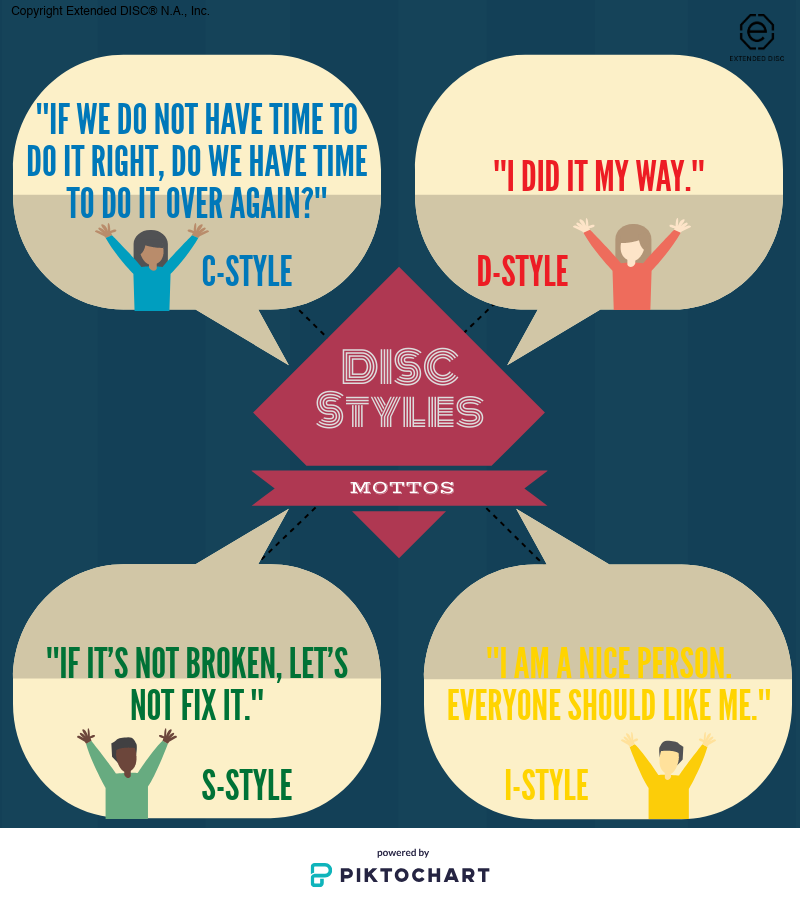
Once we are identifying the 4 DISC styles and building awareness of our own style, we can focus on observing the behavioral preferences of those around us. What are the similarities and differences in our motivators, actions, and intentions within our styles? We use this information to help us determine how to adjust to better interact with others. What is the cost if you don’t adjust? Would it ruin the family gathering if you but heads with your grumpy Uncle Ted and it starts a heated argument and creates hurt feelings?
So, why not practice during the holidays both at work and at home? It could be the secret to helping you and your loved ones get through this holiday season. So, where do you start?
It begins with us
First, we need to look within, at what brings us holiday joy and stress. Once we have a better idea of our own joys and stressors, then we can better understand them for others.
So, what brings you joy during the holidays? Make a list and be creative with it! Write down the small things and the big things that bring you joy; make sure they’re realistic so they don’t end up causing you stress! Then, choose at least one item from your list and make sure you practice it during the holiday season. Celebrate your small successes because they can add up.
Here’s a list of things that bring me joy during the holidays:
- Baking cookies
- Spending time with family
- Doing an act of service or charity
- Listening to Christmas carols
- Seeing the lights fill the darkness of the longer winter nights
- Sipping hot cocoa
- Reading by the fireplace

Now, think back over the past years about what tends to cause you stress during the holidays. What are those most dreadful moments? Again, be specific with your list. It will help you know what to avoid or adjust. Here are some of my stressors:
- Family conflicts
- Last minute shopping or wrapping presents
- Feeling obligated to bake
- Changes in plans
Your lists of joys and stressors can help you better prepare and quite possibly, help others better understand you.
Based on my holiday joys and stressors, can you identify my DISC style?
Make your own list first
Next, think about family members and co-workers you will be interacting with, either in person or virtually, over the holiday season. Identify what their main DISC style may be. Now, make a plan to avoid any stressors on their lists. How can you help them find holiday joy? What could you do? Furthermore, be on the lookout for any signs of stress you may see in them. Recognizing stress early can help both, you and the individual, manage if more effectively.
Here are some additional tips to help you:
- Have a self-care plan
We need to remember always to take care of ourselves; especially during stressful busy times. You are more equipped to take care of others when you take care of yourself first. Self-care will look and sound different for each person. That’s okay. Make sure you have a plan that works for you.
- Know your stressors
Knowing what triggers your stress, allows you to create a plan to overcome them. Have a plan in place and practice it if needed. If nothing else, always remember to breathe! - Have backup
Who’s your lifeline when the going gets tough? Do you have a signal for help and rescue? Have a plan in place. Don’t face it alone. Get others involved to help you.
Stressors will always be there. DISC provides a way to understand ourselves and others better so we can better manage the stress and have more time to focus on our joys. Are you ready for the holidays?
Sales Theory: Not Exciting, But it Works!
Sales theory breaks down the continuum of a sales job. So, how does that help you?

Wouldn’t it be great if we had a template for the perfect salesperson? Unfortunately, we all know there is no one ideal salesperson; the best person depends on what you need to accomplish in the role. People who excel at one sales role may need further development in another. For example, you have one salesperson who is tops at finding new clients, but struggles to retain them long term.
The sales theory is a basic model to help you understand the theoretical construction of the sales job using several independent continuums. How can these continuums help you better match your sales people’s’ strengths?
Sales Theory continuums

There are 18 specific sales competences in the Sales Capacity Assessment. A sales person’s competences are identified within three different continuums; how they deal with their prospects’ needs, how they perform within the sales cycle, and how they manage their relationship after they close the deal.
The first continuum is Need. The ends of the Need Continuum are Latent Need and Expressed Need. Latent Need occurs when the prospect is not aware of the need or want at the present time. Expressed Need is when the prospect is aware of the need or want.
The ends of the Sales Cycle Continuum are Short Sales Cycle and Long Sales Cycle. Short Sales Cycle involves a prospect making buying decisions quickly. The Long Sales Cycle occurs when the prospect takes time to make decisions because it has significant consequences.
The ends of the Relationship Continuum are Short Relationship and Long Relationship. Short Relationship identifies when the relationship with the prospect does not continue after the initial sale. Long Relationships continue with the prospect long after the initial sale. We can overlook a lot of business opportunities after the initial sale.
What is the value of the Sales Theory Report?
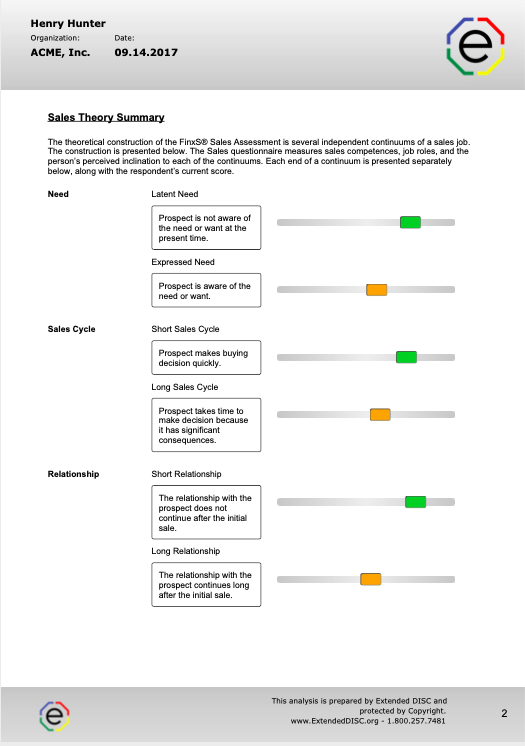
The FinxS® Sales Theory Report is a part of the FinxS® Sales Capacity Suite of tools, which measures sales competences, job roles, and the person’s perceived inclination to each of the continuums. The one-page Sales Theory report is a way to provide information quickly and concisely. At the same time, the information is complementary to other Sales Capacity Assessment reports if a deeper dive is needed.
The report identifies an individual’s current score on 6 graphs; each representing both ends of the Sales Theory continuum. It can be your best place to start when you are thinking about requirements for different sales skills for different needs and different sales cycles. It’s a quick start using a simple approach.
Coaching Tips
This information can help us to look at our sales people, prospects, and how we can make better decisions in hiring and developing our sales people.
Focus on high scores because that will help you understand the strengths that builds on your success. Often times, we are more focused on our low scores, “what am I not good at?” versus looking at what we do naturally well. Remind your sales people to maximize their strengths and to not take their strengths for granted. However, remember to not overuse them to a point of weakness.
If there is a low score and it is critical to the person’s success in their job role, then use additional information on competence development in other reports such as the Development Report. Contact us to learn more about the Sales Theory report and the Sales Capacity Assessment suite of tools.
Tips for Delivering Leadership DISC Workshops
What are some simple, yet effective tips to build better leadership DISC training content?
Continue reading “Tips for Delivering Leadership DISC Workshops”
